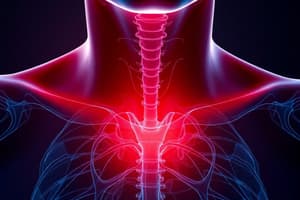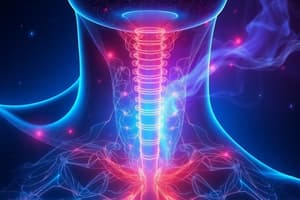Podcast
Questions and Answers
What is the primary cause of hyperthyroidism?
What is the primary cause of hyperthyroidism?
- Excess circulating levels of free thyroxine (T4) or free triiodothyronine (T3) (correct)
- Overactivity of the parathyroid gland
- Decreased metabolism leading to weight gain
- Insufficient production of thyroid hormone by the thyroid gland
Which statement describes hypothyroidism?
Which statement describes hypothyroidism?
- It leads to an accelerated metabolism.
- It is caused by inadequate production of thyroid hormone. (correct)
- It results from an excess of thyroid hormones in circulation.
- It is typically associated with parathyroid hormone imbalance.
Which of the following pharmacological treatments is primarily used for hyperthyroidism?
Which of the following pharmacological treatments is primarily used for hyperthyroidism?
- Levothyroxine
- Calcitriol
- Calcium carbonate
- Methimazole (correct)
What is a common side effect associated with treatments for hypothyroidism?
What is a common side effect associated with treatments for hypothyroidism?
What is a potential outcome of untreated hyperparathyroidism?
What is a potential outcome of untreated hyperparathyroidism?
Which condition is characterized as an autoimmune disease affecting the TSH receptor?
Which condition is characterized as an autoimmune disease affecting the TSH receptor?
What laboratory finding is indicative of hyperthyroidism?
What laboratory finding is indicative of hyperthyroidism?
Which imaging method is primarily used for assessing thyroid uptake in cases of hyperthyroidism?
Which imaging method is primarily used for assessing thyroid uptake in cases of hyperthyroidism?
What process releases T4, T3, and iodotyrosines during the biosynthesis of thyroid hormones?
What process releases T4, T3, and iodotyrosines during the biosynthesis of thyroid hormones?
Which of the following conditions is a benign tumor that cannot metastasize?
Which of the following conditions is a benign tumor that cannot metastasize?
What is the primary mechanism of action of thio(n)amides?
What is the primary mechanism of action of thio(n)amides?
Which drug has the shortest half-life among the thio(n)amides?
Which drug has the shortest half-life among the thio(n)amides?
What is a key characteristic of carbimazole in relation to methimazole?
What is a key characteristic of carbimazole in relation to methimazole?
What is one of the effects of propylthiouracil (PTU) on hormone conversion?
What is one of the effects of propylthiouracil (PTU) on hormone conversion?
What is a common reason for a latent period before clinical improvement with thio(n)amides?
What is a common reason for a latent period before clinical improvement with thio(n)amides?
Which laboratory finding is typically observed in hyperthyroidism?
Which laboratory finding is typically observed in hyperthyroidism?
What role does iodide trapping play in the biosynthesis of thyroid hormones?
What role does iodide trapping play in the biosynthesis of thyroid hormones?
Which imaging technique is specifically noted for thyroid uptake scans?
Which imaging technique is specifically noted for thyroid uptake scans?
Which condition is associated with an overgrowth of the thyroid gland?
Which condition is associated with an overgrowth of the thyroid gland?
What is a key characteristic of anti-TSH receptor antibodies in the context of hyperthyroidism?
What is a key characteristic of anti-TSH receptor antibodies in the context of hyperthyroidism?
What causes the condition known as hyperthyroidism?
What causes the condition known as hyperthyroidism?
Which of the following statements best reflects the pharmacokinetics associated with treatments for hypothyroidism?
Which of the following statements best reflects the pharmacokinetics associated with treatments for hypothyroidism?
What is a common side effect associated with the pharmacological treatment of hyperparathyroidism?
What is a common side effect associated with the pharmacological treatment of hyperparathyroidism?
What characterizes the mechanism of action of the drugs used for treating hyperthyroidism?
What characterizes the mechanism of action of the drugs used for treating hyperthyroidism?
In the context of parathyroid treatment, what is the rationale for using pharmacological agents?
In the context of parathyroid treatment, what is the rationale for using pharmacological agents?
What is the primary mechanism by which thio(n)amides reduce thyroid hormone levels?
What is the primary mechanism by which thio(n)amides reduce thyroid hormone levels?
Which thio(n)amide specifically inhibits the 5'-deiodinase enzyme responsible for converting T4 to T3?
Which thio(n)amide specifically inhibits the 5'-deiodinase enzyme responsible for converting T4 to T3?
What is a notable pharmacokinetic difference between propylthiouracil (PTU) and methimazole?
What is a notable pharmacokinetic difference between propylthiouracil (PTU) and methimazole?
How quickly can thio(n)amides lead to significant inhibition of iodine utilization in the thyroid gland?
How quickly can thio(n)amides lead to significant inhibition of iodine utilization in the thyroid gland?
What factor contributes to the latent period before clinical improvement when using thio(n)amides?
What factor contributes to the latent period before clinical improvement when using thio(n)amides?
Flashcards
Hyperthyroidism
Hyperthyroidism
A state where the thyroid gland produces too much thyroid hormone, leading to an overly active metabolism.
Hypothyroidism
Hypothyroidism
A condition where the thyroid gland produces too little thyroid hormone, resulting in a slowed metabolism.
Thyroxine (T4)
Thyroxine (T4)
The active form of thyroid hormone, crucial for regulating metabolism.
Triiodothyronine (T3)
Triiodothyronine (T3)
Signup and view all the flashcards
Pharmacokinetics
Pharmacokinetics
Signup and view all the flashcards
Graves' disease
Graves' disease
Signup and view all the flashcards
Toxic thyroid adenoma
Toxic thyroid adenoma
Signup and view all the flashcards
Toxic multinodular goitre
Toxic multinodular goitre
Signup and view all the flashcards
Serum TSH
Serum TSH
Signup and view all the flashcards
I123 (Radioactive iodine)
I123 (Radioactive iodine)
Signup and view all the flashcards
Thioureylenes (Thioamides)
Thioureylenes (Thioamides)
Signup and view all the flashcards
Pharmacokinetics of Thioureylenes
Pharmacokinetics of Thioureylenes
Signup and view all the flashcards
How PTU Works
How PTU Works
Signup and view all the flashcards
Latent Period for Thioureylene Action
Latent Period for Thioureylene Action
Signup and view all the flashcards
Thioureylenes in Pregnancy and Breastfeeding
Thioureylenes in Pregnancy and Breastfeeding
Signup and view all the flashcards
What is hyperthyroidism?
What is hyperthyroidism?
Signup and view all the flashcards
What is hypothyroidism?
What is hypothyroidism?
Signup and view all the flashcards
What are thioureylenes?
What are thioureylenes?
Signup and view all the flashcards
What is unique about Propylthiouracil (PTU)?
What is unique about Propylthiouracil (PTU)?
Signup and view all the flashcards
Why are thioureylenes preferred for treating hyperthyroidism in pregnant women?
Why are thioureylenes preferred for treating hyperthyroidism in pregnant women?
Signup and view all the flashcards
Graves' disease: autoimmune disorder targeting TSH receptor
Graves' disease: autoimmune disorder targeting TSH receptor
Signup and view all the flashcards
Toxic Thyroid Adenoma: benign tumor
Toxic Thyroid Adenoma: benign tumor
Signup and view all the flashcards
Toxic Multinodular Goiter: Overgrowth with multiple nodules
Toxic Multinodular Goiter: Overgrowth with multiple nodules
Signup and view all the flashcards
Radioactive Iodine (I123)
Radioactive Iodine (I123)
Signup and view all the flashcards
Thyroid Hormone Synthesis
Thyroid Hormone Synthesis
Signup and view all the flashcards
How do carbimazole and methimazole differ in their pharmacokinetics?
How do carbimazole and methimazole differ in their pharmacokinetics?
Signup and view all the flashcards
Why is there a delay in seeing benefits after starting thioureylene treatment?
Why is there a delay in seeing benefits after starting thioureylene treatment?
Signup and view all the flashcards
Why are thioureylenes a preferred treatment choice for pregnant women with hyperthyroidism?
Why are thioureylenes a preferred treatment choice for pregnant women with hyperthyroidism?
Signup and view all the flashcards
Study Notes
Thyroid Gland
- The thyroid gland controls metabolism in the body.
- Hyperthyroidism is high thyroid hormone in the blood, increasing the speed of body processes.
- Treatment options for hyperthyroidism include radioactive iodine, surgery, and thioureylenes.
- Patients on antithyroid drugs should be counselled about agranulocytosis.
- Beta-blockers may be used to manage excess thyroid hormone.
- Hypothyroidism is low thyroid hormone, slowing down body processes.
- Treatment for hypothyroidism is levothyroxine (LT4).
- Increased speed in all body processes is caused by High thyroid hormone present in blood.
- Reduced thyroid hormone in blood leads to slower body processes.
Parathyroid Glands
- The parathyroid gland controls calcium levels in the body.
- Hyperparathyroidism is high parathyroid hormone, leading to brittle bones (osteoporosis).
- Hypoparathyroidism is low parathyroid hormone, leading to cardiac arrhythmias, neuromuscular irritability, and tetany.
- Treatment for hyperparathyroidism is typically surgery. If not a surgical candidate, calcimimetics and bisphosphonates are options.
- Treatment for hypoparathyroidism involves calcium and 1,25-dihydroxy vitamin D.
Diseases of the Thyroid
- Hyperthyroidism ("overactive thyroid gland"): Excess circulating free thyroxine (T4) or free triiodothyronine (T3), or both.
- Hypothyroidism ("underactive thyroid gland"): Insufficient production of thyroid hormone by the thyroid gland.
- Major causes of Hyperthyroidism: Graves' disease, Toxic thyroid adenoma, Toxic multinodular goitre.
Hyperthyroidism - Learning Outcomes
- LO1: Describe the mechanism of action of drugs used to treat hyperthyroidism or hypothyroidism.
- LO2: Recall the pharmacokinetics and side effects associated with hyperthyroidism or hypothyroidism treatments.
- LO3: Describe the mechanism of action of drugs used to treat hyperparathyroidism or hypoparathyroidism.
- LO4: Recall the pharmacokinetics and side effects associated with hyperparathyroidism or hypoparathyroidism treatments.
Hyperthyroidism - Signs and Symptoms
- Signs: Normal/Distorted nail beds angle, clubbed fingers, tremors, diarrhea, menstrual changes (amenorrhea), intolerance to heat, fine/straight hair, bulging eyes, facial flushing, enlarged thyroid, tachycardia, systolic BP increase, weight loss, localized edema.
Hyperthyroidism - Diagnosis
- Laboratory: Low serum TSH, High serum T3 and T4, Anti-TSH receptor antibodies.
- Imaging: Thyroid ultrasound, Radioactive iodine imaging (using Iodine 123) to determine the cause of hyperthyroidism.
Hyperthyroidism - Imaging
- Cold Nodule, Grave's Disease, Toxic Multinodular, Hot Nodule, Autonomous Nodule, Thyroiditis
- Imaging helps identify the cause through visual characteristics of the thyroid gland.
Synthesis of Thyroid Hormones
- Iodide trapping (1st step)
- Oxidation and iodination of tyrosine residues on Tg (2nd step)
- Coupling of iodotyrosine to form T3 & T4 (3rd step)
- Proteolysis of Tg, releasing T4, T3, and iodotyrosines (4th step)
- Deiodination (5th Step)
Thyroid Treatment Options
- Thioureylenes (e.g., carbimazole, methimazole, propylthiouracil)
- Radioactive iodine (131I)
- Surgery
Thio(n)amides/Thioureylenes - Clinical Use
- Reduce the level of thyroid hormone
- Inhibits the enzyme thyroperoxidase.
Thio(n)amides/Thioureylenes - Pharmacokinetics
- Carbimazole is rapidly converted to methimazole.
- PTU has a half-life of 1 hour, methimazole 4–6 hours.
- There is a latent period of 2-4 weeks before clinical improvement.
- PTU is protein-bound, while methimazole is not.
Thio(n)amides/Thioureylenes - Adverse Effects
- Major: Agranulocytosis (0.1–0.5% risk), which can occur at any time and dosage, potentially fatal.
- Stop antithyroid medication and monitor CBC with differential if fever or sore throat.
- If granulocyte count <500, hospitalize and give broad-spectrum antibiotics.
Thyroid Drugs - When to Use Carbimazole
- Use carbimazole in all Graves' disease patients, except during the first trimester of pregnancy, thyroid storm, or adverse reactions.
Radioactive Iodine - Clinical use
- Reduce the level of thyroid hormone
- The isotope used is 131I.
- Incorporated into thyroglobulin.
- Emits gamma and beta rays (short-range emission).
- Exerts cytotoxic action (kills cells).
- Hypothyroidism often develops after treatment.
Radioactive Iodine - Pharmacokinetics
- 131 I oral administration (Single dose).
- Half-life 8 days, effects diminish to undetectable levels by 60 days.
- Action may take up to 2 weeks to have an effect.
- Potential adverse effect is nausea.
- Special precaution - not for pregnant or breastfeeding women or children.
Surgery
- Equally effective as other treatments for Graves' disease.
- Choice of therapy often involves patient-physician discussion.
- Reasons for choosing surgery include avoiding radioiodine, avoiding side effects of antithyroid drugs needing rapid reduction of hyperthyroidism and large goiters (obstructing the airway).
- Total thyroidectomy typically leads to hypothyroidism.
Adjunctive Therapy
- Iodine or glucocorticoids, used with antithyroid drugs in severe thyrotoxicosis (e.g., thyroid storm).
- Beta-adrenoceptor antagonists (e.g., propranolol) can inhibit peripheral conversion of T4 to T3, relieving adrenergic symptoms (tremor, palpitations, heat intolerance, nervousness), and are used while waiting for other drugs to take effect.
- Contraindications: asthma, heart failure, and vasoconstrictor conditions like Raynaud's syndrome.
Corticosteroids
- Can inhibit T4 to T3 conversion.
- Helpful for relieving thyroiditis inflammation/pain, and thyroid eye disease (Graves' disease).
NSAIDs
- Used in subacute thyroiditis
Hypothyroidism
- Hypothyroidism slows down bodily functions.
- Major causes include Hashimoto's thyroiditis (tissue destruction by circulating antibodies and lymphocytes), genetic factors, and iatrogenic causes (e.g., post-thyroidectomy or radiation therapy).
Hypothyroidism - Signs and Symptoms
- Symptoms: Hair loss, apathy, lethargy, dry (coarse/scaly) skin, muscle aches/weakness, constipation, intolerance to cold, receding hairline, facial edema, extreme fatigue, thick tongue, slow speech, anorexia, brittle nails/hair, menstrual disturbances, late manifestations (hypothermia, bradycardia, weight gain, LOC, thickened skin), cardiac complications.
Thyroxine & Liothyronine (LT3)
- Treatment by administering hormone directly.
- Synthetic thyroxine derivative (Hormone Replacement Therapy)
- T4 metabolically converts to T3; LT3 is rarely used except for myxedema coma or with combined T4 treatment.
- Potential side effect is iatrogenic hyperthyroidism (palpitations, nervousness, headache, difficulty sleeping, insomnia, swelling of legs/ankles, weight loss).
TSH Monitoring
- Monitoring frequency: every 6 weeks, until the results are normalized.
- Target TSH normal range: 0.5–4.5 mIU/L (0.5–2.5 mIU/L, or 1–6 mIU/L in older patients).
- Cannot rely on TSH results in secondary (pituitary) hypothyroidism.
Calcium Salts
- Replaces calcium, improves bone mineralisation, and regulates nervous/muscle tissue.
- Pharmacokinetics: Oral solution (calcium citrate/carbonate), NOT IM (causes necrosis).
- Side effects mainly include constipation and potentially chronic kidney disease/kidney stones.
Vitamin D
- Vitamin D (Calcifediol/calcitriol) binds to vitamin D-binding protein and goes throughout the body.
- Promotes calcium absorption.
- Maintains calcium & phosphate levels, important for bone mineralisation.
- Potential side effects include allergic skin reactions, calcium buildup in arteries, and cholesterol changes.
- Monitor serum and urinary Ca2+ levels.
Hyperparathyroidism
- Causes of primary hyperparathyroidism include benign growth (adenoma) on one or more glands.
- Enlargement of two or more glands also common.
Treatment Options for Hyperparathyroidism
- Treatment of choice is surgery: removal of one or more glands.
- Minimally Invasive Radioguided Parathyroidectomy (MIRP) also performed.
Calcimimetics
- Mimics calcium circulating in the blood, causing the parathyroid gland to release less parathyroid hormone.
Bisphosphonates
- Possible mechanism of action includes inhibiting osteoclast recruitment or inducing osteoclast apoptosis.
- Used for osteoporosis treatment, increasing bone density up to 10% in three years and decreasing fracture incidence.
- Systemic bioavailability is about 0.6–0.7% for women and men when under fasting conditions.
Hypoparathyroidism
- Caused by inadequate parathyroid hormone resulting in lower than normal calcium in body fluids (i.e., hypocalcemia).
Hypoparathyroidism - Causes
- Post-surgical: following total thyroidectomy or radical neck dissection.
- Infiltrative diseases: Hemochromatosis, Wilson's disease.
- Hypomagnesemia: Decreased functional activation of adenylate cyclase leads to decreased PTH activity.
- Congenital defects in DiGeorge syndrome (formation of branchial pouches 3, 4, and 5), Familial syndromes (e.g., autoimmune polyglandular syndrome type 1), and hereditary resistance to parathyroid hormone (pseudohypoparathyroidism).
- Renal tubule dysfunction where they fail to respond to the presence of parathyroid hormone.
Questions & Answers (Q&A)
- Q1: The most serious side effect of carbimazole in a patient with Graves' disease is agranulocytosis.
- Q2: Carbimazole blocks the synthesis of thyroid hormone.
Studying That Suits You
Use AI to generate personalized quizzes and flashcards to suit your learning preferences.



